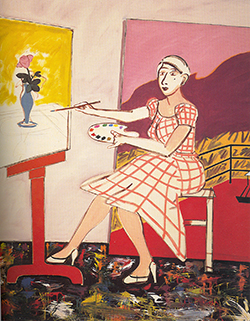Personal Stories
Her early accomplishments establish Brown as a pioneering woman artist who achieved success prior to the women's movement. While she was a trailblazer, she had no premeditated feminist agenda. A fascinating tension existed between her words and her practice during that pivotal time of social transformation. She found the feminist approach "a totally exterior motivation for working"7 – and thus contradictory to her own process. Yet, even in the 1950s and 1960s, her subject matter aligned closely with the personal and psychological imperatives of feminist art. Brown was motivated to find the "feminine" in her art not by suggestion or mandate, but by her own interests as an artist.
There is a connection between Brown's introspective approach to art and the consciousness-raising encouraged by the women's movement. Although the feminist adage that the "personal is political" implies too much purposeful protest and activism to be applied to Brown's work, she thoroughly painted the details of her life and experiences to arrive at larger issues on the roles and representation of women in society. In Self-Portrait (1977), Brown called into question the stereotypical image of the female artist. She depicted herself perched on a chair, legs daintily crossed, wearing clean, white gloves, high heels, and a fashionable print dress. With a fine brush, she paints a still life with a flower – a genre often stereotyped as for housewife hobbyists and, thus, not serious artists. In reality, Brown was often covered from head to toe in paint when she worked—a truthful nod to her process suggested in the paint-splattered floor and the large painting-in-progress behind the figure (The Kiss, 1979). In 1979, Frank Goodyear, then curator at the Pennsylvania Academy of the Fine Arts, Philadelphia, included Brown in his exhibition Seven on the Figure and asserted: "Brown's Self-Portrait is essentially a caricature of the modern female artist as comprehended by modern society; it speaks to the public's expectations of a female artist and indirectly to Brown's commitment to disabuse the public of these traditional ideas."8 Brown arrived at conclusions about women's roles in society (in her case, the reality and validity of being an artist and female) by exploring her own life.


